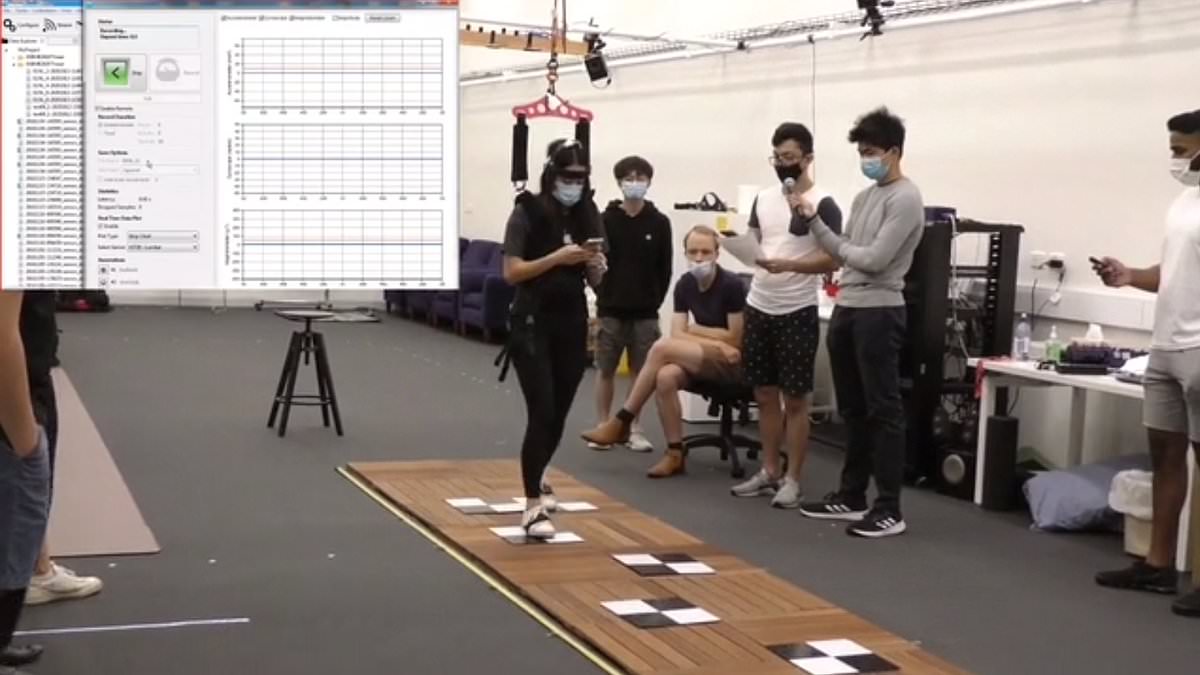The dangers of ‘TWALKING’: People who text and walk at the same time are more likely to suffer serious fall
- Even when test subjects tried to be cautious, texting and walking increased falls
- Subjects’ texting speed and accuracy dropped by half on moderate-risk walks
- READ MORE: Texting and driving ‘slows reaction times more than drink or drugs’
It is a warning shot for those who insist upon wandering along the street gazing down at their smart phone.
Rather unsurprisingly, texting while walking makes you more likely to fall down.
Researchers asked 50 young adults to walk along a tiled path, which sometimes had a sliding tile that would cause them to slip.
They did so either without texting, or while typing the phrase ‘The quick brown fox jumps over the lazy dog’ into their phone without predictive text.
Texting was found to increase the risk of accidental falls in the study volunteers, who were recorded slipping, but wore a safety harness to prevent them actually falling to the ground.
The finding that texting pedestrians risk falling over may seem obvious, but motion sensors attached to each person provided insight into why texting while walking is potentially such a bad idea.
Researchers asked 50 young adults to walk along a tiled path, which sometimes had a sliding tile that would cause them to slip. Texting was found to increase the risk of accidental falls in the study volunteers, who wore a safety harness to prevent them actually falling to the ground
The study attached motion sensors to each person’s head, torso, pelvis and feet to track their balance (graphs above). They were asked to walk along the normal tiled walkway, once when told there was no threat of slipping, then twice more, warned that they could or could not slip
Previous studies have shown that texting pedestrians are more likely to collide with other people and to cross the road into oncoming traffic
When people texted, their gait was less stable and they were less able to recover their balance.
The study authors suggest it could be helpful for mobile phones to have a ‘texting lock’ which prevents people typing on their devices when they are walking in areas with trip hazards, like roadside footpaths.
‘On any day it seems as many as 80 percent of people, both younger and older, may be head-down and texting,’ said neuroscientist and engineer Matthew Brodie, the study’s lead author and a senior lecturer the University of New South Wales in Australia. ‘I wondered, is this safe?’
‘This has made me want to investigate the dangers of texting while walking,’ Brodie said.
‘I wanted to know if these dangers are real or imagined, and to measure the risk in a repeatable way.’
The study attached motion sensors to each person’s head, torso, pelvis and feet.
They were asked to walk along the normal tiled walkway, being told there was no threat of slipping.
Then they walked along it twice, each time being warned that they could or could not slip.
In one of these cases, the warning was true, as tile had been adjusted to slide out of place.
These three walking experiments were conducted on people both when they were texting and when they were not.
When people were texting and slipped on the walkway, their torso swayed to a greater extent – likely because they went from leaning forwards over their phone to slipping backwards.
Walking was also found to cause texters’ speed and accuracy to decrease by roughly half on just moderately risky walks, compared to the typing they achieved sitting down, (graph A at left). Walking speed also was diminished by texting, based on their research (graph B at right)
This could make it harder to recover balance.
When walking normally, when walking under threat of slipping, and when actually slipping, people appeared to have a less stable head, torso and pelvis when they were texting at the same time.
The motion data showing that texting participants tried to be more cautious in response to the threat of slipping, such as walking more slowly, and spending more time with both feet planted on the ground.
But unfortunately this cautiousness did not appear to counteract their risk of falling.
If the study result is not enough to tear some people away from their phones, the finding that texts are more likely to go wrong when people send them while walking, may have more impact.
Walking was found to cause texters’ accuracy to decrease, compared to the typing they achieved sitting down, according to the study published in the journal Heliyon.
Previous studies have shown that texting pedestrians are more likely to collide with other people and to cross the road into oncoming traffic.
Source: Read Full Article







